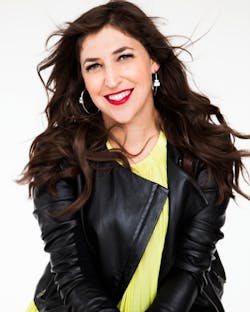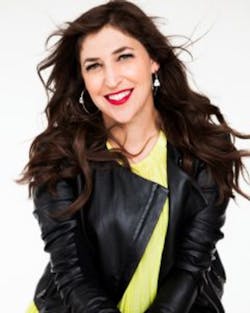San Diego, CA. IPC Apex Expo 2017 got underway this morning with a keynote address by the actor Mayim Bialik, who also earned a Ph.D. in neuroscience from UCLA.
Bialik plays a neurobiologist on the TV comedy The Big Bang Theory, where her character interacts with other scientists and an engineer. Her Apex keynote was titled “The Big Bang Theory: Making Science Cool (& Funny).” That might seem an unusual topic for a technical audience already likely convinced that STEM subjects are at least “cool”—if not necessarily funny. But she tailored her talk to the audience, recounting how she became an actor and a student of neuroscience. She commented on how her roles have affected her two sons and offered suggestions to audience members during an extended question-and-answer session.
She showed her geek credentials by taking a selfie with the audience and displaying her Casio digital watch at the beginning of her talk. She then described her unusual journey—being a scientist and playing one on TV. One advantage of being a scientist vs. an actress, she joked, is no one cares if you wear makeup.
Bialik described herself as the grandchild of immigrants. Three of her grandparents emigrated from Poland, Czechoslovakia, and Hungary before the Second World War.
Her parents, unable to afford dental or medical school, chose a typical route for first-generation Americans to take—becoming English teachers. Her parents raised her with the notion that students were part of an extended family. She described a bohemian upbringing—when she was born she and her parents lived in one of her grandparents’ living room in San Diego. The family subsequently moved to Los Angeles, where she has remained throughout her life.
Her father was also a filmmaker, which might have piqued her interest in acting. In fact, as an 11-year-old, she was interested in school plays. But the traditional route for child actors—advertising—was blocked for her, as ethnic faces were not likely to be chosen for such roles at the time. She took on “character roles”—available to those lacking the “leading lady” look—in films such as Beaches, where she played Bette Midler’s character as a young girl.
From 1991 to 1995, Bialik, born in 1975, played the title role in a TV show called Blossom. Interestingly, this role played a key role in developing her interest in science. She described herself as having been a so-so student—intense but always rushing. She said the most common mark she received on her assignments was “CE”—for “careless error.” Further, she had the perception that science was not for girls—“all the boys said so!”
But a confluence of events presented her with an opportunity. She said the school busing system in place at the time enabled her to attend a better school than was available in her neighborhood. Further, TV roles for child actors precluded normal school attendance, and it was typical for such children’s parents or agents to advertise for tutors in various specialties to augment their education. An advertisement for a biology tutor for a 15-year-old actress led Bialik to a woman biologist. “It was the first time I had the opportunity to work one-on-one with a woman, and I became as enthralled with biology as my parents were with art and literature,” Bialik said. “[The tutor] gave me the confidence and passion and skillset to move forward in STEM.”
Bialik went on to pursue undergraduate studies at UCLA in STEM studies, with a minor in Hebrew and Jewish studies (to help keep her GPA—and her morale—up, she joked). She was accepted for graduate work at Harvard and Yale, but decided to continue her Ph.D. program near home at UCLA.
Ultimately, after a 12-year break from acting in the pursuit of science, she decided to return to acting as the best solution for her family.
In a question-and-answer session at the conclusion of her talk, she addressed questions such as whether The Big Bang Theory helps break down stereotypes—or reinforces them. She said many of her friends are like characters in the show, but that doesn’t totally answer the question, and I’ve written more about the topic in “Smithsonian curator looks at TV program’s effect on scientists’ image.”
But the show does present scientists in a social environment far removed from the lone scientist in a lab. Alternatives include working with animals, being teachers, or communicating about science. She said she hopes that with 20 million viewers a week, The Big Bang Theory is doing its part to promote interest in STEM education.
Parents have been interacting with their children for hundreds of thousands of years, she said, trying to tell appropriate stories. Today, she added, we live in a scientific world, and children deserve an age-appropriate answer to their questions. “Connect with them about the wonders of the world,” she concluded.
About the Author

Rick Nelson
Contributing Editor
Rick is currently Contributing Technical Editor. He was Executive Editor for EE in 2011-2018. Previously he served on several publications, including EDN and Vision Systems Design, and has received awards for signed editorials from the American Society of Business Publication Editors. He began as a design engineer at General Electric and Litton Industries and earned a BSEE degree from Penn State.

